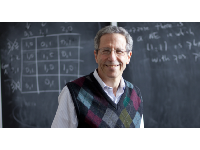Economics Institute of the Czech Academy of Sciences (as part of a joint workplace CERGE-EI) hosted a five-day visit by Eric Maskin, Adams University Professor at Harvard University and recipient of the 2007 Nobel Prize in Economics (with L. Hurwicz and R. Myerson) for his work laying the foundations of ‘mechanism design.’ On April 29th, Prof. Maskin gave a public lecture at CERGE-EI titled “How to Make the Right Decisions without Knowing People’s Preferences: An Introduction to Mechanism Design”.
To begin his lecture, Prof. Maskin contrasted the field of ‘mechanism design’ with other more
familiar components of economic theory. Whereas the bulk of economics takes existing institutions
as given and aims to understand and explain outcomes delivered by those institutions, mechanism
design reverses the direction. It starts by identifying desirable outcomes and asks whether one can
design institutions to achieve them and, if so, what these institutions ought to look like. In this
sense, mechanism design can be called an “engineering” component of economic theory and is
sometimes called reverse game theory.
To further illustrate the concept, Prof. Maskin offered three concrete applications of
mechanism design theory. They were, in the order presented, (1) how to divide a good between two
people in a way that neither of them envies the share of the other, (2) how a government can sell a
license to allow transmission over a band of radio frequencies to a company which values it most,
and (3) how to choose a public energy source when individual preferences are different and optimal
choice depends on the unknown state of the world. Prof. Maskin explained how insights from
mechanism design theory can provide answers to these intractable questions.
Simple as they are, these examples illustrate key features of mechanism design. First, a
designer of the mechanism does not know what the optimal outcomes should be. Secondly, the designer
must proceed to indirectly convince participants to reveal necessary information. Finally,
participants have their own goals and motivations which may not coincide with those of the
designer. Therefore, the mechanism must be ‘incentive compatible’—in other words, it should
recognize those goals and reconcile them with those of the designer.
The examples presented during the lecture displayed transparent mechanisms that are
implemented to achieve the designer’s goals. For those interested in a general way to understand
whether a goal is implementable and how to find a mechanism to implement it, Prof. Maskin referred
to his seminal paper, “
Nash Equilibrium and Welfare Optimality.” Prof. Maskin concluded with some
further examples of possible future applications of mechanism design theory, namely the development
of an international treaty on greenhouse gas emissions and the design of policies to prevent
financial crises.
Prof. Maskin’s visit is part of CERGE-EI’s long-running ‘Distinguished Speaker Series’, which
consistently brings world-famous economists to Prague for public lectures. Previous speakers
include luminaries of economic thought such as Kenneth Arrow (Stanford, 1972 Nobel Laureate) and
Robert Solow (MIT, 1987 Nobel Laureate), and more recently Joseph Stiglitz (Columbia, 2001 Nobel
Laureate), Christopher Sims (Princeton, 2011 Nobel Laureate), and Alan Krueger (Princeton). Several
of these scholars have served on CERGE-EI’s Executive and Supervisory Committee. Since this year,
CERGE-EI has joined Tatra banka Foundation in co-organizing an annual Nobel Prize Lecture Series
that is going to bring a Nobel Laureate in Economics to the region. As part of this partnership,
Prof. Maskin also gave a
filmed lecture on the topic of financial crises to a large audience at the
Comenius University in Bratislava.
17 Jun 2013






